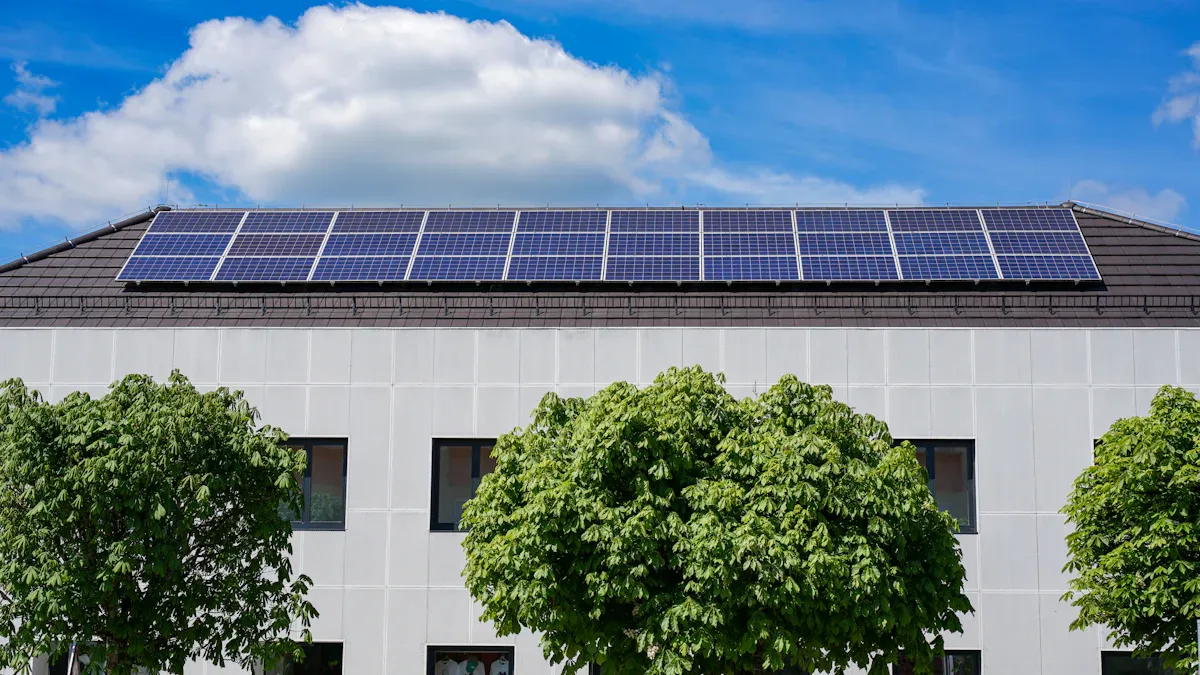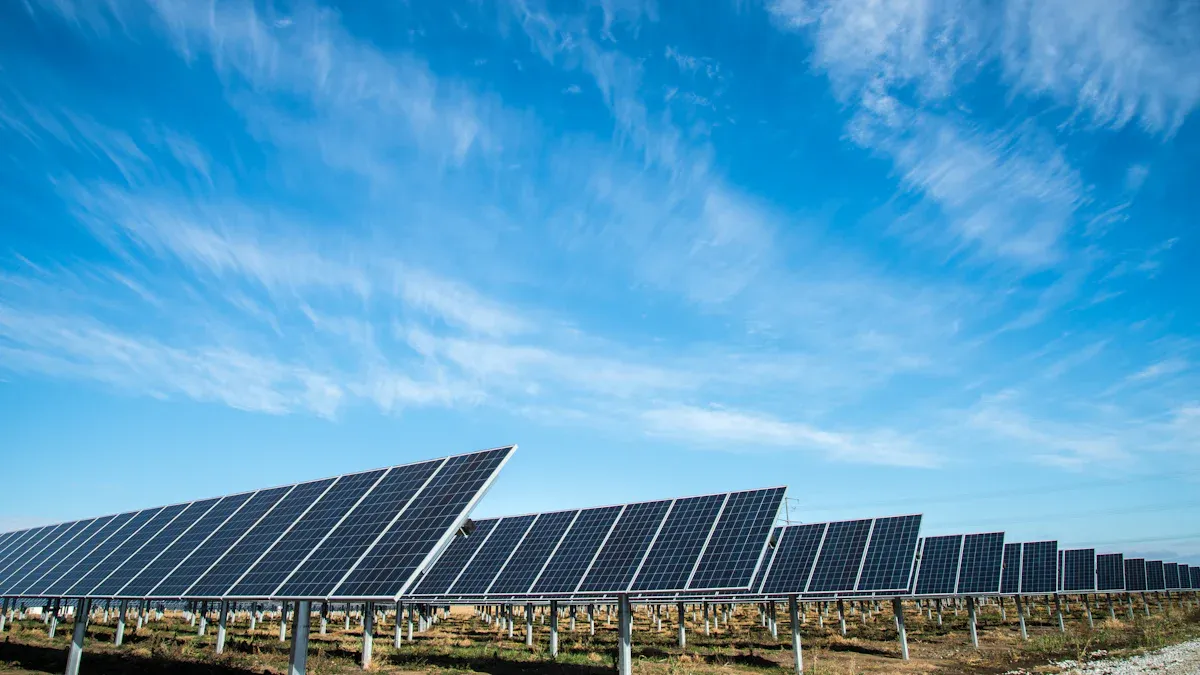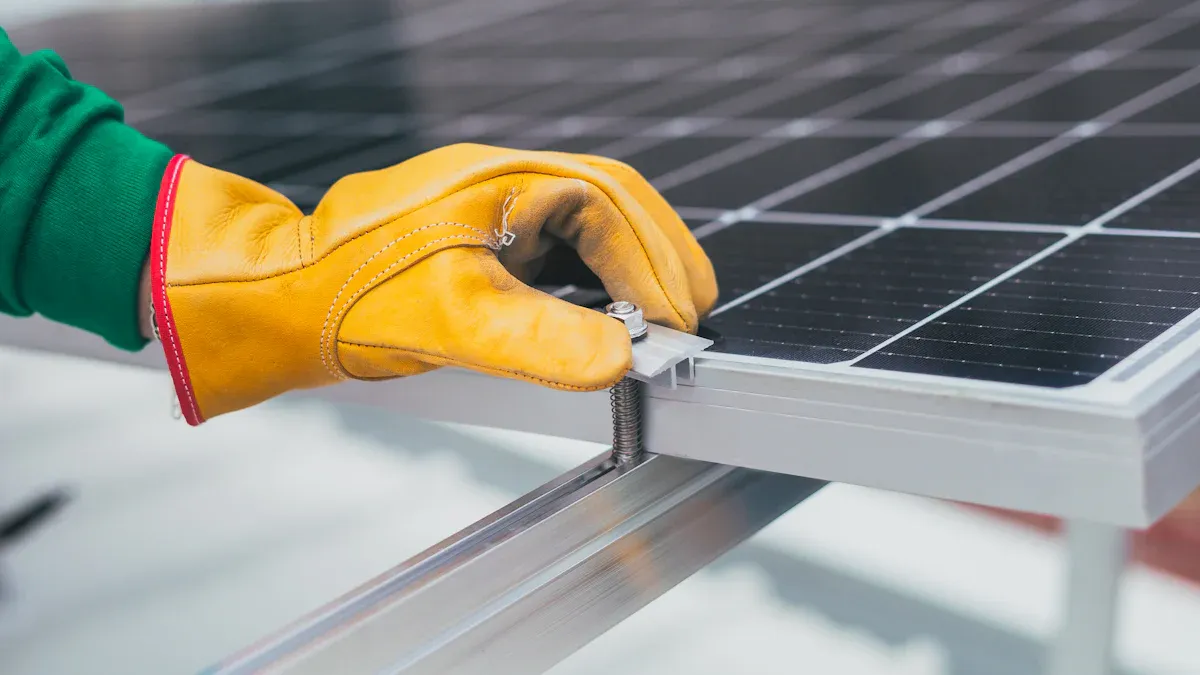Buying ESTEL PV Panels in 2025 Made Simple

Switching to solar in 2025 is one of the smartest decisions you can make for your home. ESTEL PV panels offer cutting-edge technology that maximizes energy efficiency, ensuring you get the most out of your solar energy system. With energy costs rising, investing in solar reduces your monthly bills while increasing your home's value. These panels are built to last, delivering reliable energy even in challenging weather conditions. Before you buy PV panels, understanding your energy needs and the benefits of this investment will help you make a confident purchase.
Key Takeaways
Using ESTEL PV panels in 2025 can cut energy costs and boost home value.
Buying efficient solar panels means fewer installations, saving money and space.
Look into federal and state programs to make solar cheaper and save more.
Pick strong panels that handle bad weather for steady energy all year.
Check if your roof works with solar and plan for future energy needs.
Key Benefits of Buying ESTEL PV Panels

Advanced solar technology for better efficiency
ESTEL PV panels use cutting-edge solar technology to deliver exceptional efficiency. These panels are designed to capture more sunlight and convert it into usable energy, even in low-light conditions. With advancements like multi-layered cells and anti-reflective coatings, you can maximize your energy output and reduce reliance on traditional power sources. This means you’ll enjoy consistent energy production throughout the year, regardless of seasonal changes.
Tip: Higher efficiency panels can help you meet your energy needs with fewer installations, saving space on your roof and reducing upfront costs.
Long-term cost savings and increased home value
Investing in ESTEL PV panels offers significant financial benefits over time. Homeowners who install solar panels can save approximately $48,000 on electric bills over 25 years. The average installation cost for a home solar system in 2025 is projected to be $29,360 before tax credits. After applying federal solar incentives, the net cost drops to about $20,552. These savings make solar a smart long-term investment.
Additionally, buying a home with solar panels increases its resale value. Homes equipped with solar systems are more attractive to buyers, as they promise lower energy costs and a sustainable lifestyle. If you’re considering buying a house with solar panels, you’ll benefit from reduced electric bills and a higher property value.
Key Financial Benefits:
Electric bill savings of up to $48,000 over 25 years.
Reduced upfront costs with federal tax incentives.
Increased resale value for homes with solar systems.
Positive environmental impact and sustainability
Choosing ESTEL PV panels contributes to a cleaner, greener planet. The production process for these panels incorporates waste reduction strategies, cutting costs and minimizing environmental harm. For example, waste disposal is reduced by approximately 48%, equating to 10,145 Mg per year. Vertical integration and revalorized waste strategies further lower environmental impacts by up to 2.3%.
By switching to solar, you reduce your carbon footprint and support sustainable energy practices. Every kilowatt-hour of solar energy generated replaces fossil fuel-based electricity, helping combat climate change. Installing solar panels is more than an investment in your home; it’s a commitment to a healthier future for the planet.
Note: Sustainability isn’t just about reducing waste; it’s about creating a long-term impact that benefits both your wallet and the environment.
Durability and performance in diverse weather conditions
When you invest in ESTEL PV panels, you gain a solar solution designed to withstand the challenges of diverse weather conditions. These panels are engineered with durability in mind, ensuring consistent performance regardless of the climate in your area.
Built to Last in Extreme Weather
ESTEL PV panels feature robust materials that resist wear and tear caused by harsh weather. Whether you live in a region with heavy snowfall, intense heat, or frequent storms, these panels maintain their efficiency. The tempered glass and corrosion-resistant frames protect the panels from physical damage, while advanced sealing prevents moisture from compromising their functionality.
Tip: If your area experiences frequent hailstorms, look for panels with high impact resistance ratings to ensure long-term reliability.
Reliable Energy Production in All Seasons
Weather fluctuations can affect solar energy production, but ESTEL panels are designed to adapt. Their high-temperature tolerance ensures optimal performance during summer, while their low-light efficiency keeps energy flowing on cloudy days. Even in winter, when sunlight is limited, these panels capture and convert available light effectively.
Key Features for Weather Adaptability:
Anti-reflective coatings for better energy absorption in low-light conditions.
High wind resistance, tested to withstand speeds up to 140 mph.
Snow load capacity exceeding industry standards.
Tested for Longevity
Every ESTEL PV panel undergoes rigorous testing to ensure it meets international durability standards. These tests simulate extreme weather scenarios, including heavy rain, hail, and prolonged UV exposure. The results guarantee that your panels will last for decades without significant degradation.
Note: Panels with certifications like IEC 61215 and IEC 61730 offer added assurance of quality and durability.
Why Durability Matters for You
Durable panels save you money on repairs and replacements. They also provide peace of mind, knowing your solar system will continue to perform even during unexpected weather events. By choosing ESTEL PV panels, you invest in a reliable energy source that protects your home and your wallet.
Benefits of Durable Panels:
Reduced maintenance costs over time.
Consistent energy production in challenging climates.
Enhanced safety during extreme weather events.
🌞 Durability Tip: Regular cleaning and inspections help maintain your panels' performance and extend their lifespan.
How to Choose the Right ESTEL Solar Panels

Comparing panel types and efficiency ratings
Choosing the right solar panels starts with understanding the different types available. ESTEL offers monocrystalline, polycrystalline, and thin-film panels, each with unique benefits. Monocrystalline panels provide the highest efficiency, making them ideal for homes with limited roof space. Polycrystalline panels offer a cost-effective solution for larger installations. Thin-film panels work well for unconventional surfaces, such as curved roofs or portable setups.
Efficiency ratings play a crucial role in determining the performance of your solar panels. Higher efficiency panels convert more sunlight into usable energy, reducing the number of panels needed for your system. ESTEL panels feature advanced technology, such as multi-layered cells and anti-reflective coatings, to achieve industry-leading efficiency.
Tip: Compare the efficiency ratings of different panel types to find the best match for your energy needs and budget.
Determining the right size for your energy consumption
Sizing your solar system correctly ensures it meets your energy needs without overproducing or underproducing. Start by analyzing your electricity bills to calculate your average monthly energy consumption. This helps you estimate the number of panels required for your home.
Consider factors like roof space and sunlight exposure when determining the system size. If your roof has limited space, opt for high-efficiency panels to maximize energy production. For homes with ample roof area, a larger system with standard panels may be more cost-effective.
Note: Oversizing your system can lead to unnecessary costs, while undersizing may not cover your energy needs. Balance is key.
Finding a certified installer for solar panels installed
A certified installer ensures your solar panel installation is safe, efficient, and compliant with local regulations. Look for professionals with certifications that guarantee expertise and reliability.
Certification | Description |
|---|---|
NABCEP | The gold standard for solar installers, requiring advanced coursework, hands-on experience, and a rigorous exam. Ensures trusted expertise and higher-quality installations. |
AZROC | A legal requirement in Arizona for contractors, ensuring they meet basic qualifications and safety codes. |
APS Qualified Technology Installer | Certification for installers who meet APS's strict quality standards and have undergone specific training. Ensures reliability and safety in grid integration. |
Certified installers follow best practices for solar panel installation, ensuring your system operates efficiently and lasts for decades. They also help navigate permits and inspections, saving you time and effort.
Pro Tip: Ask for references and read customer reviews to verify the installer’s reputation before hiring.
Evaluating customer reviews and brand reputation
When choosing ESTEL PV panels, evaluating customer reviews and the brand’s reputation helps you make an informed decision. Reviews provide insights into real-world experiences, while a strong reputation reflects consistent quality and reliability.
Why Customer Reviews Matter
Customer reviews reveal how ESTEL panels perform after installation. They highlight key aspects like energy efficiency, durability, and post-installation support. Positive reviews often indicate satisfied customers who achieved their energy goals. Negative reviews can uncover potential issues, such as delayed installations or poor customer service.
Tip: Focus on reviews that mention long-term performance and maintenance experiences. These give you a clearer picture of how the panels will function over time.
How to Analyze Reviews
Look for patterns in feedback rather than relying on individual opinions. If multiple customers praise the panels’ efficiency, it’s likely a reliable feature. Similarly, repeated complaints about installation delays may signal a problem. Pay attention to reviews from homeowners with similar energy needs or climates to yours.
Key Points to Evaluate in Reviews:
Energy production consistency.
Ease of installation and support.
Warranty claims and customer service responsiveness.
Assessing Brand Reputation
A brand’s reputation reflects its commitment to quality and customer satisfaction. ESTEL has built a strong reputation by delivering innovative solar solutions and excellent support. Industry awards, certifications, and partnerships with trusted organizations further validate the brand’s reliability.
Note: Brands with certifications like ISO 9001 or partnerships with renewable energy organizations often demonstrate higher standards of quality.
Making an Informed Choice
Combine customer reviews with brand reputation research to make the best decision. A well-reviewed product from a reputable brand ensures you invest in panels that meet your expectations.
🌟 Pro Tip: Check independent review platforms and forums for unbiased opinions. Avoid relying solely on testimonials from the brand’s website.
Common Mistakes to Avoid When You Buy PV Panels
Ignoring future energy needs and scalability
When purchasing solar panels, planning for your future energy needs is essential. Many homeowners focus only on their current electricity usage, overlooking potential changes like adding electric vehicles, expanding their homes, or adopting more energy-intensive appliances. This short-sighted approach can lead to an undersized solar system that fails to meet your growing energy demands.
To avoid this mistake, consider long-term energy consumption trends. For example, advanced forecasting methods, such as the Prophet model, analyze seasonal variations and long-term patterns in solar energy use. These tools provide accurate predictions, helping you design a scalable solar system.
Trend | Description |
|---|---|
Extend forecasting techniques | Analyze uncertainty factors over longer time horizons. |
Consumer behavior | Understand how social acceptance impacts solar adoption. |
Energy balance | Evaluate how solar energy integrates with your consumption. |
Tip: Choose panels with higher efficiency and ensure your inverter can handle additional capacity if you decide to expand your system later.
Overlooking local regulations and permits
Navigating local regulations and permits is a critical step in your solar installation journey. Ignoring these requirements can result in delays, fines, or even the removal of your panels. Each state and municipality has unique rules governing solar installations, including net metering policies, grid access charges, and environmental compliance.
For instance, obtaining permits demonstrates adherence to planning laws and environmental regulations. Larger projects, like solar farms, often require additional permissions from regulatory authorities. Early engagement with your local community and thorough environmental assessments can streamline the process.
Aspect | Importance |
|---|---|
Importance of Permits | Ensures compliance with environmental and planning laws. |
Best Practices | Engage communities early and conduct thorough assessments. |
Planning Permission | Mandatory for larger projects requiring regulatory consent. |
Note: Stay updated on regulatory changes in your area to avoid unexpected costs or project delays.
Choosing based solely on the lowest solar panel cost
Opting for the cheapest solar panels might seem like a good way to save money, but it often leads to higher costs in the long run. Low-cost panels may lack durability, efficiency, or reliable warranties, resulting in frequent repairs or replacements.
Price comparison studies highlight the risks of prioritizing cost over quality. For example, a 2015 multi-state study revealed that while the average premium per watt for high-quality panels was $4.18, the net cost per watt was only slightly lower for cheaper options at $4.14. This small difference in upfront cost can translate into significant performance and reliability gaps over time.
Reminder: Focus on the overall value of the panels, including efficiency, warranty, and long-term energy savings. High-quality panels slash electric bills and provide better returns on your investment.
Neglecting post-purchase support and warranties
Ignoring post-purchase support and warranties can lead to costly mistakes. Solar panels are a long-term investment, and their performance depends on proper maintenance and reliable support. Without these, you risk unexpected expenses and reduced energy production.
Why Post-Purchase Support Matters
Post-purchase support ensures your solar system operates efficiently after installation. Providers like ESTEL offer services such as system monitoring, troubleshooting, and customer assistance. These services help you identify and resolve issues quickly, minimizing downtime and maximizing energy output.
Tip: Choose a provider with a dedicated support team that offers real-time monitoring tools. This helps you track your system’s performance and detect problems early.
The Importance of Warranties
Warranties protect your investment by covering defects and performance issues. A product warranty guarantees the quality of materials and workmanship, while a performance warranty ensures your panels maintain a specific energy output over time. Without these warranties, you may face high repair or replacement costs.
Warranty Type | Coverage |
|---|---|
Product Warranty | Covers defects in materials or manufacturing. |
Performance Warranty | Ensures panels maintain energy output levels. |
Reminder: Look for warranties that last at least 25 years for performance and 10-15 years for product defects.
How to Avoid This Mistake
Evaluate the post-purchase services and warranty terms before buying solar panels. Ask your provider about maintenance plans, system monitoring options, and warranty coverage. Read customer reviews to understand how well the company supports its clients after installation.
🌟 Pro Tip: Keep all warranty documents and service records organized. This ensures you can claim benefits if issues arise.
Neglecting post-purchase support and warranties can compromise your solar investment. By prioritizing these factors, you protect your system and enjoy reliable energy for decades.
Choosing ESTEL PV panels in 2025 offers unmatched benefits for your home. These panels deliver reliable solar energy, reduce your monthly costs, and increase your property value. By taking advantage of incentives, you can make this investment even more affordable. Thorough research ensures you select the right panels and avoid common mistakes when you buy PV panels. Consulting a trusted ESTEL provider simplifies the process and guarantees a smooth purchase experience. Start your journey toward a sustainable home today.
FAQ
What is the lifespan of ESTEL PV panels?
ESTEL PV panels typically last 25-30 years. Their advanced materials and rigorous testing ensure durability and consistent performance over time. Regular maintenance, such as cleaning and inspections, can extend their lifespan and maximize energy production.
How much maintenance do solar panels require?
Solar panels need minimal maintenance. Cleaning them twice a year to remove dirt and debris is usually enough. Annual professional inspections help identify issues early. ESTEL panels are designed for durability, reducing the need for frequent repairs.
Tip: Use water and a soft brush for cleaning to avoid scratches.
Can solar panels work during cloudy days or winter?
Yes, ESTEL PV panels generate energy even in low-light conditions. Their advanced technology captures sunlight efficiently during cloudy days and winter months. While production may decrease slightly, you’ll still benefit from consistent energy output.
Are ESTEL PV panels compatible with all roof types?
Most roof types can support ESTEL PV panels. South-facing roofs with minimal shading work best. If your roof isn’t ideal, consider ground-mounted systems or community solar programs as alternatives.
Roof Type | Compatibility |
|---|---|
South-facing | Excellent |
Flat Roofs | Good |
Shaded Roofs | Limited |
What happens if my solar panels produce excess energy?
Excess energy can be sent back to the grid through net metering programs. You’ll receive credits for the surplus, which can offset future electricity bills. This makes solar energy even more cost-effective.
Reminder: Check your local utility’s net metering policies for specific details.
See Also
Innovative Energy Storage Solutions for ESTEL Telecom Cabinets
Advanced Battery Systems for ESTEL Telecom Energy Needs
Solar-Powered Energy Storage Solutions for Telecom Cabinets
Eco-Friendly Outdoor Communication Cabinets Designed for 2025
Integrated Solar Inverter and Battery Systems for Telecom Use
CALL US DIRECTLY
86-13752765943
3A-8, SHUIWAN 1979 SQUARE (PHASE II), NO.111, TAIZI ROAD,SHUIWAN COMMUNITY, ZHAOSHANG STREET, NANSHAN DISTRICT, SHENZHEN, GUANGDONG, CHINA

